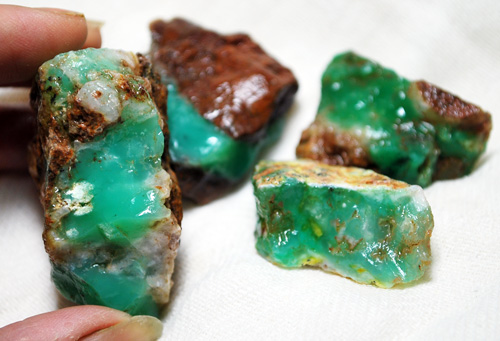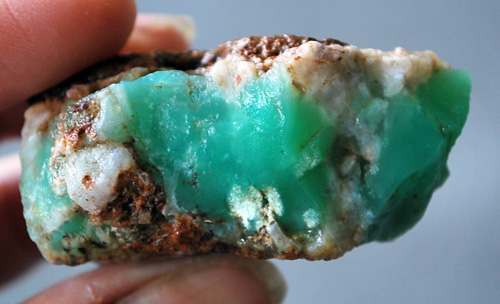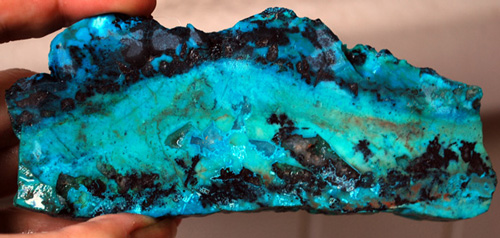herchenx
Cave Dweller 
Member since January 2012
Posts: 3,360
|
Post by herchenx on Apr 1, 2012 13:45:13 GMT -5
|
|
|
|
Post by helens on Apr 2, 2012 0:41:25 GMT -5
That's an interesting rock... but looks nothing like pietersite. I thought pietersite only comes from China and Nambia Africa... and nowhere else. If he's not in China or Africa and telling you he's got Pietersite (and that rock is not even remotely like it), I'd be a bit skeptical about anything else he tells you by way of ID.
This weekend, I got a CRASH course in visually identifying most gems/minerals by looking/handling some world class pieces, and that rock doesn't even look like chrysocolla to me, which has way way more blue than that...
He/you should send some pieces to a University or something for definite ID. That said, have you cut any? How does it look cut:)?
|
|
Jason
starting to spend too much on rocks
 
Member since March 2009
Posts: 216
|
Post by Jason on Apr 2, 2012 22:49:58 GMT -5
The only thing that would be gem silica is those little blue spots and chances are they are chrysocolla. Gem silica is rare and somewhat pricey. Folks like to use the terms interchangeably but they are not the same. The only thing they share is both are colored by copper salts. Chrysocolla is not to rare and wqith a hardness of only 2-3 it's not very suitable for jewelry. gem silica on the other hand is microcrystalline quartz colored by copper. It has hardness suitable for jewelry, being a 7. It's a stone that for all intents and purposes should be extremely popular but I think due to the rarity of it it's never made a splash. The color of the finest paraiba tourmaline coupled withg a good hardness makes for a world class gemstone. the only thing holding it back it's it's lack of transparent material. Some comes very very close to being fully transparent but never all the way from what I have seen. Here are a few examples of killer gem silica   |
|
herchenx
Cave Dweller 
Member since January 2012
Posts: 3,360
|
Post by herchenx on Apr 2, 2012 22:57:37 GMT -5
The guy showed me cabs he had that were small and not homogenous but definitely had some gemmy material in the mix.
I will be working this up and the little I have played with is interesting.
|
|
herchenx
Cave Dweller 
Member since January 2012
Posts: 3,360
|
Post by herchenx on Apr 2, 2012 22:58:34 GMT -5
Oh and that is some sweet gem silica!
|
|
Minnesota Daniel
freely admits to licking rocks
   A COUPLE LAKERS
A COUPLE LAKERS
Member since August 2011
Posts: 891
|
Post by Minnesota Daniel on Apr 10, 2012 19:03:42 GMT -5
He didn't mean to say Peristerite did he? Is the color actually in the stone, or could it be labradorescence? Parts of the last pic sort of look iridescent.
|
|
Sabre52
Cave Dweller  Me and my gal, Rosie
Me and my gal, Rosie
Member since August 2005
Posts: 20,504
|
Post by Sabre52 on Apr 10, 2012 19:41:08 GMT -5
*L* Pulling a bucket from an empty well here. I'm not much of a mineral guy, I'm more into agate and jasper type materials, and that looks like pretty complex stuff. Definitely does not appear to be pietersite as it lacks chatoyance ( spelled right Rich ?). Looks to be a quartzy copper ore complex of some sort with maybe some chrysocolla thrown in. Maybe Jamie will look at this. Her and Rodney mine copper ore bodies all the time and some of her examples are quite complex. She'd certainly have a better idea than I would....Mel
|
|
Deleted
Deleted Member
Member since January 1970
Posts: 0
|
Post by Deleted on Apr 14, 2012 22:13:24 GMT -5
Chrysoprase?
|
|
|
|
Post by helens on Apr 15, 2012 0:03:40 GMT -5
Well, if this helps, here's chrysoprase from Tanzania (from John at johnjsgems if you need some). They are gorgeous, and look a lot like the gem silica- actually, almost exactly the same color. They look a little bit like your rocks... but maybe the location is different?   I'm going to guess the hardness at 6-7... no way you can scratch these with a fingernail, but digging hard you can scratch with steel. Hope that helps:). |
|
|
|
Post by helens on Apr 15, 2012 11:57:42 GMT -5
This is Chrysocolla from Tony (he labels it gem crysocolla, and this is not very soft like regular chrysocolla is, 2.5-3.5 on hardness, it seems harder because you cannot scratch it with fingernail, but still very fragile). Gem Silica is also called gem chrysocolla, and are separated by grading, Jason's is top grade gem silica. Chrysocolla (in all forms) is a rare form of chalcedony colored with copper (softness due to inclusion of other minerals). Chrysoprase is a rare form of chalcedony colored with nickel. That's the wiki difference anyway. The chrysocolla color is a really intense blue green (the chrysoprase is actually a more apple green blue-green):  Your rocks have a slightly waxy sheen on the side that has the most color, and that's what my chrysoprase is like too. Also, the chrysocolla is more of a matt finish, while the chrysoprase is glassy without polish, but that may have more to do with rock grade than properties. It is definitely not pietersite. |
|
|
|
Post by gingerkid on Apr 15, 2012 13:45:28 GMT -5
Hi, I think it looks like chrysoprase, very similar to the material that Helen posted of the material from Tanzania. I think it is colored by nickel.
I have a couple of pieces of rough of the Tanzanian chrysoprase that I purchased from Mr. Daryl Blair, but haven't attempted cabbing any of it yet.
|
|
|
|
Post by gingerkid on Apr 15, 2012 13:47:16 GMT -5
 Lol, after taking a second look at your pics, herchenx, I see some pretty robin's egg blue color in the first photo.  Maybe it's a mix of mins with chrysocolla? Pretty stuff!!
|
|
pilotgemstone
off to a rocking start

Member since December 2013
Posts: 6 
|
Post by pilotgemstone on Nov 14, 2014 3:54:43 GMT -5
I love chrysocolla gemsilica
|
|
pilotgemstone
off to a rocking start

Member since December 2013
Posts: 6 
|
Post by pilotgemstone on Nov 14, 2014 4:07:25 GMT -5
I have stock of rough chrysocolla gemsilica, grade A. you can contact my fb: pilotgemstone@yahoo.com
or Handi Johan. thanks
|
|